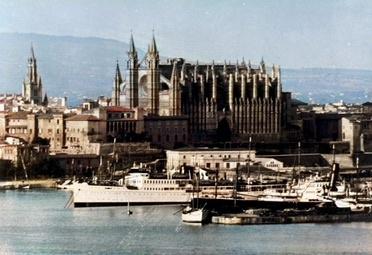How did King Jaume I influence the development of La Seu Cathedral?
Similar Topics
king jaume i
la seu cathedral
gothic architecture
palma de mallorca
christian reclamation
political power
religious hub
crown of aragon
King Jaume I, also known as James I of Aragon, played a crucial role in the development of La Seu Cathedral in Palma de Mallorca, which stands as a remarkable testament to Gothic architecture. After conquering Mallorca in 1229, Jaume I initiated the construction of the cathedral on the site of a former mosque, symbolizing the Christian reclamation of the island. His reign marked the beginning of a significant transformation, as the cathedral was intended not only as a place of worship but also as a statement of political and religious power. Although Jaume I did not live to see the cathedral completed, his vision and patronage laid the essential groundwork for a structure that would grow in grandeur over the following centuries.
Jaume I’s influence extended beyond merely ordering the cathedral’s construction; his political ambitions shaped its function and presence within the city. He preferred a prominent architectural symbol that would assert Christian dominance and inspire devotion, which is why La Seu Cathedral was designed on a grand scale. The foundation and initial phases of the cathedral reflect the King’s commitment to establishing a central religious hub for the newly conquered territory. This commitment attracted skilled artisans and resources, helping to elevate the project's scope and prestige. Thus, Jaume I’s involvement was pivotal in setting the course for the cathedral's evolution, ensuring it became one of Mallorca’s most iconic landmarks.
Moreover, the cathedral’s development over time remained closely tied to the legacy Jaume I left behind. His initial initiative created a continuous impetus for enhancements and expansions carried out by subsequent rulers and architects, who honored his original purpose. The cathedral embodies the historical narrative of Mallorca’s integration into the Crown of Aragon, a narrative that began with Jaume I’s conquests and enduring authority. For visitors today, La Seu Cathedral stands not only as an architectural marvel but also as a symbol of the transformative impact King Jaume I had on Mallorca’s religious and cultural landscape.
Jaume I’s influence extended beyond merely ordering the cathedral’s construction; his political ambitions shaped its function and presence within the city. He preferred a prominent architectural symbol that would assert Christian dominance and inspire devotion, which is why La Seu Cathedral was designed on a grand scale. The foundation and initial phases of the cathedral reflect the King’s commitment to establishing a central religious hub for the newly conquered territory. This commitment attracted skilled artisans and resources, helping to elevate the project's scope and prestige. Thus, Jaume I’s involvement was pivotal in setting the course for the cathedral's evolution, ensuring it became one of Mallorca’s most iconic landmarks.
Moreover, the cathedral’s development over time remained closely tied to the legacy Jaume I left behind. His initial initiative created a continuous impetus for enhancements and expansions carried out by subsequent rulers and architects, who honored his original purpose. The cathedral embodies the historical narrative of Mallorca’s integration into the Crown of Aragon, a narrative that began with Jaume I’s conquests and enduring authority. For visitors today, La Seu Cathedral stands not only as an architectural marvel but also as a symbol of the transformative impact King Jaume I had on Mallorca’s religious and cultural landscape.
🧩 Related Questions
Related Question
How does the architecture and design of the Palau de Marivent reflect its function as a royal summer retreat?
Related Question
Are there any citrus festivals or events in Mallorca that travelers can attend to learn about local fruit cultivation?
Related Question
What traditional methods did Mallorcan families use to maintain the cleanliness of their stored cistern water?
